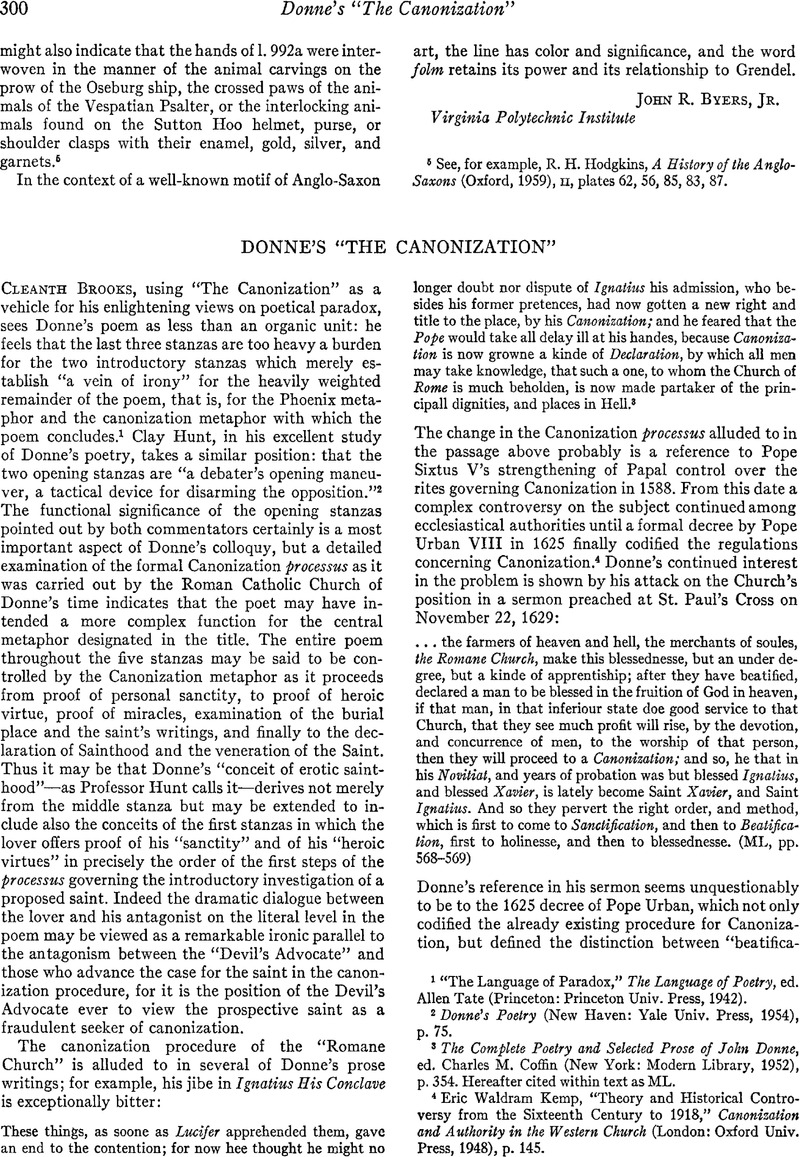Article contents
Donne's “The Canonization”
Published online by Cambridge University Press: 02 December 2020
Abstract

- Type
- Notes, Documents, and Critical Comment
- Information
- Copyright
- Copyright © Modern Language Association of America, 1965
References
1 “The Language of Paradox,” The Language of Poetry, ed. Allen Tate (Princeton: Princeton Univ. Press, 1942).
2 Donne's Poetry (New Haven: Yale Univ. Press, 1954), p. 75.
3 The Complete Poetry ani Selected Prose of John Donne, ed. Charles M. Coffin (New York: Modern Library, 1952), p. 354. Hereafter cited within text as ML.
4 Eric Waldram Kemp, “Theory and Historical Controversy from the Sixteenth Century to 1918,” Canonization and Authority in the Western Church (London: Oxford Univ. Press, 1948), p. 145.
5 The Catholic Encyclopedia, ed. Charles Herbernein et al. (New York, 1907), p. 366.
6 Reverend Thomas F. Macken, The Canonization of Saints (Dublin, 1910), p. 35.
7 “Outline of the Procedure for Canonization.”
8 It would appear that Donne's pattern for the poem follows the procedure taken for the Canonization of “Confessors”—those pious men who lead heroically virtuous lives of self-denial, that is, lives of “prolonged martyrdom”—rather than the considerably less complex processus involved in the Canonization of “Martyrs.”
9 There is no more reason to believe, with Doniphan Louthan, The Poetry of John Donne: A Study in Explication (New York, 1951), p. 112, that the speaker's “five gray hairs” refers to “greying temples,” than that it refers to an advanced stage of baldness, an affliction which would have shades of meaning not inconsistent with “palsie,” “gout,” and “ruin'd fortune” for 17th-century readers.
10 Macken, p. 154.
11 Macken, p. 158.
12 A remarkable similarity exists between Donne's conceits and a description of the Phoenix legend by the fourth century Roman Christian poet, Lactantius. Lactantius' poetic description reads: “non huc exsangues Morbi, no aegra Senectus / nec Mors crudelis nec Metus asper adest / nec Scelus infandum nec opum vesana Cupido / aut Ira aut ardens caedis amore Furor; … non ibi tempestas nec vis furit horrida venti / nec gelido terram rore pruina tegit.” “Phoenix,” Minor Latin Poets, eds. J. Wight Duff and Arnold M. Duff (Cambridge: Harvard Univ. Press, 1934). Compare this with Donne's passage in connection with the Phoenix from his “XXII Meditation”: “there is a propensenesse to diseases in the body, out of which without any other disorder, diseases will grow, and so wee are put to a continuali labour upon this farme, to a continuali studie of the whole complexion and constitution of our body. In the distempers and diseases of soiles, sourenesse, drinesse, weeping, any kinde of barrennesse, … and there rises a kinde of Phoenix out of the ashes, a fruitfulnesse out of that which was barren before, and by that, which is the barrennest of all, ashes” (ML, 455). Although this “Meditation” undoubtedly postdates “The Canonization,” it is significant that Donne compares bodily illnesses with illnesses of the earth in general in much the same fashion as they are set down in the first two stanzas of the poem. In both works the comparisons culminate in the figure of the Phoenix.
13 Macken, p. 67.
14 “The Language of Paradox,” p. 54. Brooks observes: “The comparison of the lovers to the phoenix is very skillfully related to the two earlier comparisons, that in which the lovers are like burning tapers, and that in which they are like the eagle and the dove. The phoenix comparison gathers up both.”
15 Macken, p. 115.
16 Macken, p. 169.
17 Although there is no doctrine of the Catholic Church expressly forbidding cremation, traditionally the practice of interment in the earth has been observed. It would be highly desirable in the Canonization rites investigation for the remains of a saint to be specifically identifiable, which, of course, ironically, they would not be, in the poem.
18 Brooks, p. 53.
19 The Poems of John Donne (Oxford: Clarendon Press, 1912), p. 16.
- 5
- Cited by


